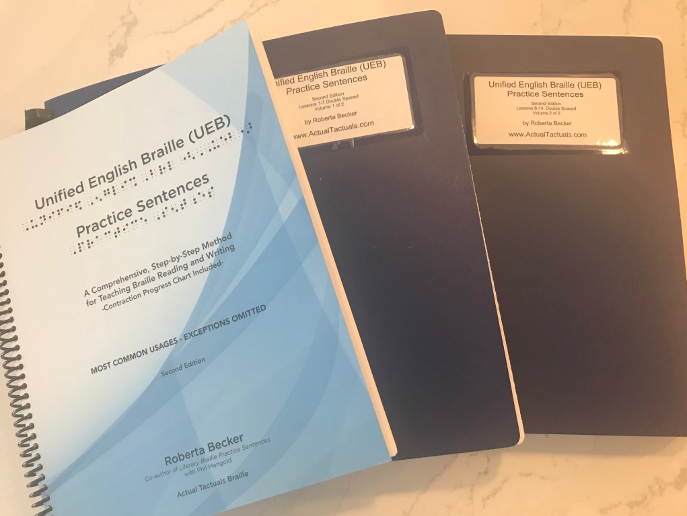
Suggestions for Teaching Braille Reading and Writing Remotely
Tips for using Unified English Braille (UEB) Practice Sentences for online instruction with students who are blind or visually impaired.
Try these easy suggestions for teaching reading and writing remotely, using “Unified English Braille (UEB) Practice Sentences” books in braille and print.
Everything is already done for you:
- Lessons are planned for all contractions, and commonly used punctuation and math symbols.
- Books are available in braille, already embossed.
- Please see website for detailed description of systematic and progressive lessons, specifically designed to make it easy to learn to read and write braille contractions.
These books will make it EASY for the teacher to have reading and writing lessons REMOTELY. The child can read by using a speakerphone or wearing headphones, leaving their hands free to read! Writing can be monitored by having the child use Perky Duck, or other suggestions, below.
Teachers are successfully using this book remotely. Everything is done for you! Lessons are planned in a very systematic way and the braille books are already embossed. These books WILL make it much easier for the TVI to have braille reading and writing lessons, remotely. All you need is to have the student’s braille books at the child’s home and the print or braille teacher’s edition at your home. We can ship the books separately to the students and/or the TVI, depending on what you feel best suits your particular circumstance.
*IMPORTANT: Parents do NOT need to know ALL of the rules of braille to work with their child.
Parents will need to know a little bit about the structure of the braille cell (dot numbers) and basic information about contractions.
Suggestions for reading or writing lessons that can be used by teachers or parents:
- For READING lessons: Using a braille book at home, the child can read sentences to you (TVI) over speakerphone or with a headset on the phone, or you can use FaceTime, or any other remote method you can think of. The TVI would need to have a print book at home. Or, of course, if the parent has the print book at home, the parent can reinforce the lessons.
-
Parents can do the following to support their children:
- 1) Read along with the child
- 2) Take turns reading with the child
- 3) Begin by reading the sentences out loud first, as the student reads along, so the student knows what he/she is going to read. This helps the child feel comfortable and confident. It allows the child to begin to recognize the contractions.
- 4) Sentences should definitely be read more than once.
- 5) Once the child is able to read the sentences comfortably, they can review sentences before the next day’s lesson.
- For WRITING lessons: The TVI or the parent can read sentences aloud for the student to write on the braillewriter. After the sentences are written, using the simulated braille sentences that are in the book, the parent can confirm that the child has done a great job. Or, the sim-braille sentences can be used to help the child make corrections. If the child is able, after the child has written the sentences on a braillewriter/notetaker, the child can self-correct by comparing what he/she has written to the sentences in the braille book. It depends on the student’s abilities. The child may need assistance in locating the correct sentences.
Ways to send braille writing to the TVI:
- The student can write on Perky Duck, and email it to the teacher.
- The parent can take pictures of the braille writing and send it to the teacher via mobile phone. Braille pages can be colored over with crayon or Expo eraser, for better contrast, if needed.
All of this will enable you to continue braille lessons while the child is at home. An added benefit is that it will help the parents to become involved with the child’s braille education, and the child may actually benefit from this aspect.
PRICES ARE REDUCED TO PROMOTE REMOTE TEACHING. Learn more.
